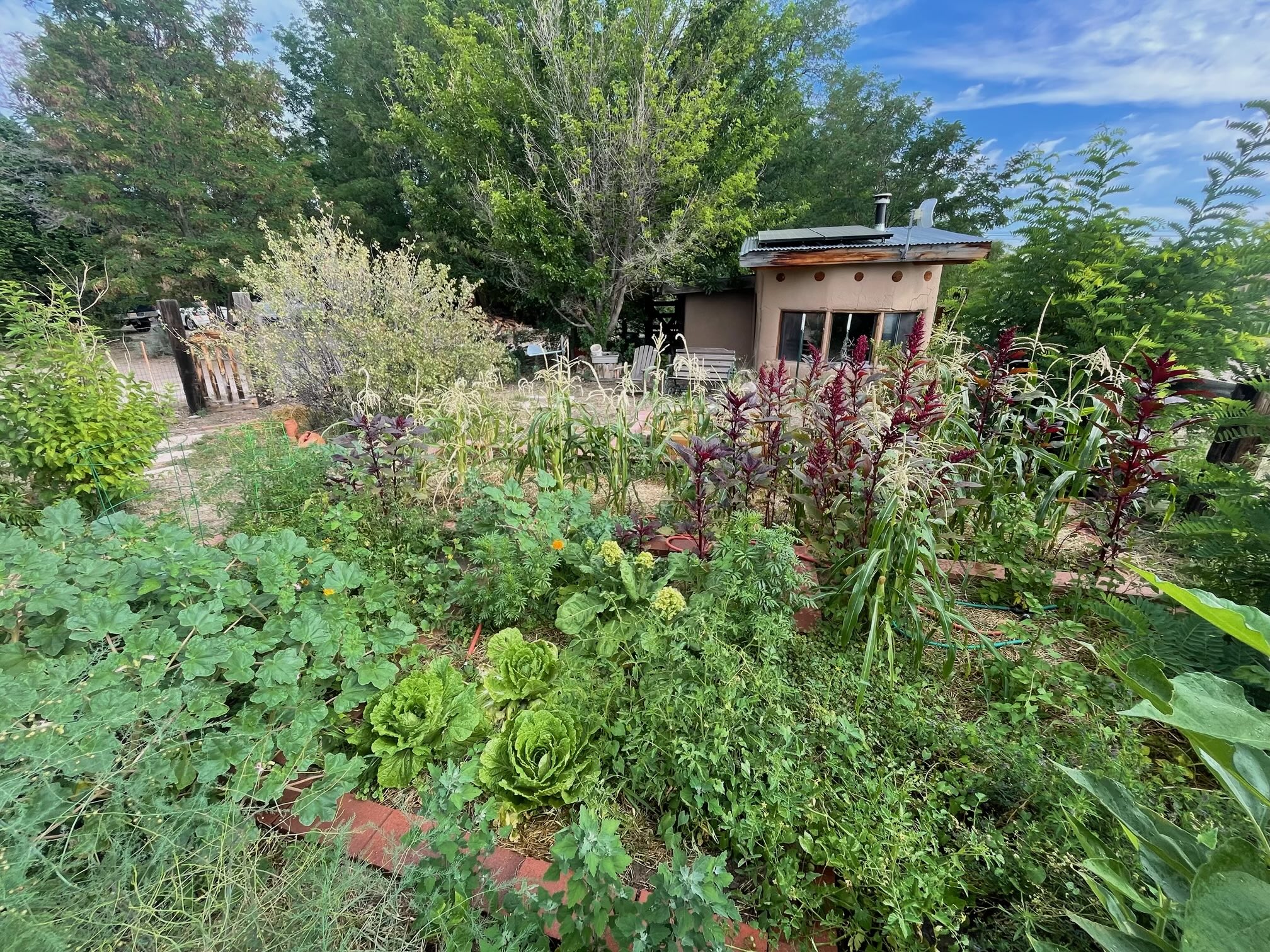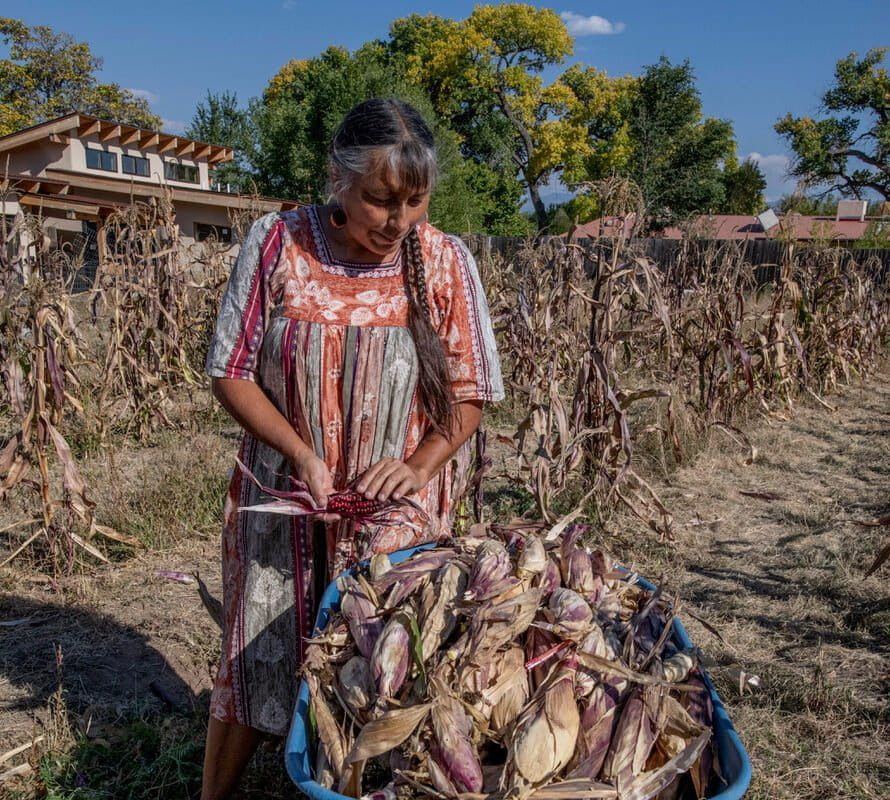Native American farmers in the southwestern United States have long deployed weather-adaptive techniques to grow crops such as corn and beans in high-desert environments only occasionally visited by rain.In recent years, a variety of tribal groups have arisen to train the next generation of Native American farmers as a means of promoting cultural identity and improving self-sufficiency, health and well-being while using farming strategies that have worked for centuries on arid lands.The techniques range from hillside terracing and “waffle” gardening, to water conservation and leveraging microclimates on a piece of land.During Native American Heritage Month in November, Mongabay spoke with the leaders of these groups about their traditional farming techniques and how they can be replicated in increasingly dry regions around the world.
See All Key Ideas
In 1985, with two young daughters and little money, Roxanne Swentzell, a Native American sculptor and ceramic artist, returned from her studies in Portland, in the U.S. state of Oregon, to her Santa Clara Pueblo community in New Mexico state. Her art was years away from producing real income, so she took to the land to sustain herself and her girls.
“I had this dry patch in the high desert, nothing but a driveway really,” recalls Swentzell, who was just 23 at the time. “I started making it into a homesite, a farm I could cultivate to feed my family. And in time, a little forest.”
To grow corn and squash, onions and garlic, beans, berries and amaranth grains, Swentzell tapped into the ancient, dry-farming traditions of her people in the southwestern U.S., where sunshine is as abundant as rain is scarce.
These proven, age-old farming techniques — applicable to many other parched, arid regions affected by climate change — have deep and expanding roots among Hopi and Navajo tribes in Arizona while experiencing a resurgence among the Pueblos (Indigenous tribes) of New Mexico through groups such as the Traditional Native American Farmers Association (TNAFA) and the Hopi Tutskwa Permaculture initiative.
During Native American Heritage Month in November, Mongabay spoke with the leaders of these groups about their traditional farming techniques and how they can be replicated in increasingly dry regions around the world.
 In Santa Fe, saving traditional seeds native to the Southwestern US high desert, such as these corn varieties, are a key component to dry farming using age-old Native American farming techniques. Image courtesy of Roxanne Swentzell.
In Santa Fe, saving traditional seeds native to the Southwestern US high desert, such as these corn varieties, are a key component to dry farming using age-old Native American farming techniques. Image courtesy of Roxanne Swentzell.
The goal in the U.S. Southwest is to provide training and encouragement to new generations of Native Americans by promoting adaptive farming strategies, seed libraries of heirloom crops, and the notion that better food will lead to better health, physically and spiritually.
“From top to bottom, these groups and their leaders are making sure our communities are exchanging knowledge and that we’re helping each other be successful in feeding our communities,” says Geoffrey Kie, a member of the Laguna Pueblo in southern New Mexico, whose work as a videographer with the Pueblo Action Alliance contributes to raising awareness.
Among the patriarchs sharing his accumulated wisdom is Clayton Brascoupe, co-founder of TNAFA, who has been dry farming, saving seeds and providing farming mentorship for decades.
At a presentation at the National Museum of the American Indian in Washington, D.C., Brascoupe described his determination to make traditional farming an important part of the lives of young people in his communities. It’s a lesson he said he absorbed from his elders decades ago as he learned dry-farming techniques from them.
“When [the elders] saw a decline in agriculture, the amount of people planting,” Brascoupe recalled, “they saw a decline in physical health. But they also were noticing a decline in sort of the social health of communities.”
Not surprisingly, Brascoupe’s path crossed that of Roxanne Swentzell, as the young artist’s mission was expanding to include food activism.
Soon, they would be offering training courses together, reaching hundreds of young Native Americans throughout New Mexico, with hundreds more trained in Arizona in similar programs.
 Jars and containers of seeds housed in a small building on Roxanne Swentzell’s property. Image courtesy of Roxanne Swentzell.
Jars and containers of seeds housed in a small building on Roxanne Swentzell’s property. Image courtesy of Roxanne Swentzell.
 A garden spot on Roxanne Swentzell’s property in the Santa Clara Pueblo of New Mexico overflows with vegetables like cabbage and squash and grains like amaranth. The small building in the background is used for storing seeds from season to season. Image courtesy of Roxanne Swentzell.
A garden spot on Roxanne Swentzell’s property in the Santa Clara Pueblo of New Mexico overflows with vegetables like cabbage and squash and grains like amaranth. The small building in the background is used for storing seeds from season to season. Image courtesy of Roxanne Swentzell.
Waffles and mulch
Initially, Swentzell’s embrace of ancient, high-desert farming was focused on the health of her own family.
On her small plot of land, she dug waffle gardens — grid-like sunken beds with earthen walls that resemble a waffle — to retain moisture and avoid runoff when the occasional rains did come. Terracing on hillsides and mulching serves a similar purpose in dry farming; composting helps aerate and enrich the dense soil.
Swentzell also identified microclimates on her land. A large, well-placed rock would slow the flow of water and provide shade and cooling. The fruit trees she planted and nurtured did the same. She watched the sun as it moved around her adobe house, making sure her berry bushes and seeds were planted where they could thrive.
“Every place on your land has a microclimate,” she tells Mongabay, “and it’s kind of just taking note of what that area has available to it, maybe to collect water, or collect soil that’s a microclimate of nutrients and moisture. The more you understand, the more you are going to choose to plant your seeds in the microclimate that it needs.”
Swentzell added chickens, turkeys, sheep and beehives to her half-acre (one-fifth of a hectare) property as her garden became a biodiverse farm. Each plays an important role in making sure nothing grown goes to waste and that waste is used as organic fertilizer. Turkeys also provide pest control, and all the species — crops, birds, animals, insects — become sustainable food sources.
 A traditional waffle garden, like this one in New Mexico, has grid-like sunken beds with earthen walls that capture rain, retain moisture and prevent runoff. Image by Geoffrey Kie.
A traditional waffle garden, like this one in New Mexico, has grid-like sunken beds with earthen walls that capture rain, retain moisture and prevent runoff. Image by Geoffrey Kie.
 Roxanne Swentzell harvesting drought-resistant corn on her garden plot in the Santa Clara Pueblo of New Mexico. Image courtesy of Roxanne Swentzell.
Roxanne Swentzell harvesting drought-resistant corn on her garden plot in the Santa Clara Pueblo of New Mexico. Image courtesy of Roxanne Swentzell.
As her passion for desert farming and seed saving grew, Swentzell’s desire to inspire her community of 7,000 blossomed as well. In 1989, she founded the Flowering Tree Permaculture Institute to provide mentoring and training.
But it was slow to catch on.
“I was seen as a really strange person doing strange things because I was the only one in the area doing what I was doing. I have made a garden and forest out of my property using centuries-old techniques,” she says, “I am saving the crops of our ancestors. I am saving seeds. I offered to give them away. For free. I offered and offered. And there was no interest.”
Then the COVID-19 pandemic descended in March 2020, reducing access to fresh food.
“Suddenly, I got a lot more interesting,” Swentzell jokes. “People were now asking me for seeds, and I was very happy to give them away. It’s been like that ever since.”
Building on tradition
In northern Arizona, on the vast Hopi and Navajo reservations of more than a million acres (400,000 hectares), high-desert dry farming and permaculture techniques have no need to make a comeback like in New Mexico. They never really went away.
“In the Hopi community, where we live and where we work, it’s really important to understand that farming is a part of our culture,” says Lilian Hill, who in 2004 helped form a youth leadership project, a community initiative called Hopi Tutskwa Permaculture. The group works to maintain cultural identity, often through traditional farming and knowledge sharing from one generation to the next.
Hill hails from an environmental justice background. Two decades ago, she was involved in political activism aimed at protecting Native land from corporate or state resource extraction like coal mining. This formed part of her impetus to help connect young tribal members to a love of the land and what it can provide.
“Permaculture is rooted in Indigenous knowledge and tradition, first of all,” Hill says. “And although the term was coined by Western folks, the actual techniques, ideas and design framework come from Indigenous territory and Indigenous worldview.”
 Roxanne Swentzell harvesting drought-resistant corn on her garden plot in the Santa Clara Pueblo of New Mexico. Image courtesy of Roxanne Swentzell.
Roxanne Swentzell harvesting drought-resistant corn on her garden plot in the Santa Clara Pueblo of New Mexico. Image courtesy of Roxanne Swentzell.
Terracing, land contouring, mulching, waffle gardening — at scales far larger than Roxanne Swentzell’s former driveway — help make arid, sunbaked land productive with a bit of irrigation where possible, and careful water retention of rain and snowmelt.
“Using drought-adapted seeds and knowing where to plant those seeds is critical,” Hill says of heirloom corn and beans. “As dry farmers, it’s very important for us to be connected and to keep an eye on the weather as the seasons come and go. We have an agricultural calendar that guides us as Hopi people. We depend on observation and feeling, sensory skills. And we don’t plant all at one time. Each seed, each crop has it’s time.”
The beneficiaries of such Native American farming traditions extend beyond the Southwest. In Oakland, California state, for example, Crystal Wahpepah, a member of the Kickapoo Nation of Oklahoma, owns and operates Wahpepah’s Kitchen. There, she uses the kind of farm-to-table traditional farming techniques to enrich her restaurant menu nutritionally and culturally.
From her perch in New Mexico, where she worries about climate change and drought, Swentzell sees the need for such ancient agricultural wisdom to spread even further.
“This is something the whole world needs at this time, because we’re all in the same boat,” she says. “We’re having to deal with a very unstable world around us. So, we’re waking up to the fact that we need to do something. We know that what we’re doing now has worked for centuries before us. And it can work well into the future.”
Banner image: Roxanne Swentzell harvesting drought-resistant corn on her garden plot in the Santa Clara Pueblo of New Mexico. Image courtesy of Roxanne Swentzell.
Justin Catanoso, a regular contributor to Mongabay, is a professor of journalism at Wake Forest University in North Carolina.
Photos: Ethiopian farmers blend tradition, innovation to sustain centuries-old agriculture
Feedback: Use this form to send a message to the author of this post. If you want to post a public comment, you can do that at the bottom of the page.


Comments are closed.